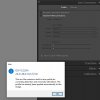That's how it used to be but Adobe Camera Raw has not provided any updates for DJI cameras since before the P4 pro more than 2 years ago.As far as I know, all raw editors use correction files that are included in the software. The software installs new profiles/correction files during updates. This is necessary because new cameras and lenses are constantly being developed. In the case of Lightroom they are probably .lcp or maybe lcr files.
Nowdays Adobe software finds all it needs in the raw image files, while less mainstream programs show you the uncorrected image.











